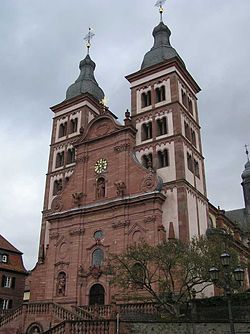| Revision as of 14:48, 16 June 2016 editDrow69 (talk | contribs)Extended confirmed users8,486 edits moving stuff on organ from Amorbach article← Previous edit | Revision as of 14:59, 16 June 2016 edit undoDrow69 (talk | contribs)Extended confirmed users8,486 edits →External links: fix linkNext edit → | ||
| Line 85: | Line 85: | ||
| ==External links== | ==External links== | ||
| * {{de icon}} | * {{de icon}} | ||
| * {{de icon}} | * {{de icon}} | ||
| ;Attribution | ;Attribution | ||
Revision as of 14:59, 16 June 2016
| This article includes a list of references, related reading, or external links, but its sources remain unclear because it lacks inline citations. Please help improve this article by introducing more precise citations. (July 2015) (Learn how and when to remove this message) |
| Kloster Amorbach | |
 Amorbach Abbey church Amorbach Abbey church | |
 | |
| Monastery information | |
|---|---|
| Order | Benedictines |
| Established | 8th century |
| Disestablished | 1803 |
| Architecture | |
| Style | Baroque/Rococo |
| Site | |
| Location | Amorbach, Germany |
| Public access | partial |
Amorbach Abbey (German: Kloster Amorbach) was a Benedictine monastery located at Amorbach in the district of Miltenberg in Lower Franconia in Bavaria, Germany.
History
It was one of four Carolingian foundations intended to establish Christianity in the region of the Odenwald (the others were the monasteries of Lorsch, Fulda and Mosbach). It is said to take its name from Amor, a disciple of Saint Pirmin, regarded as the founder. The abbey was consecrated in 734. By 800 it had become a Reichsabtei, the abbot being directly answerable to Charlemagne. Pepin united it to the Bishopric of Würzburg, although control of it was much disputed by the Bishops of Mainz.
The abbey played an important role in the clearing and settlement of the vast tracts of forest in which it was located, and in the evangelisation of other areas, notably Saxony: many of the abbots of the missionary centre of Verden an der Aller - later to become the Bishops of Verden - had previously been monks at Amorbach. It was severely damaged by the invasions of the Hungarians in the 10th century.
In 1525 the buildings were stormed and plundered during the German Peasants' War by forces under the command of Götz von Berlichingen. During the Thirty Years' War the abbey was attacked by the Swedes in 1632, was dissolved for a short time between 1632 and 1634 and the lands taken by a local landowner, and although it was afterwards restored and the lands regained, there followed a period of decline and poverty.
In 1656 the Bishops of Mainz and Würzburg reached agreement: Amorbach was transferred into the control, both spiritual and territorial, of the Archbishop of Mainz, and significant building works followed. In the 1740s the site was completely refurbished in the Rococo style, of which it remains a significant example, under the supervision of Maximilian von Welsch. Further extensive construction and decoration was undertaken in the 1780s, including in 1782 the installation of what was at the time the biggest organ in the world.
The patrons were the Virgin Mary, with Saints Simplicius, Faustinus and Beatrix.
Dissolution
The abbey was finally dissolved in 1803 and given with its lands as compensation for lost territories to the Princes of Leiningen, who still live there today. Jurisdiction over the abbey and its territories passed to the government of the Kingdom of Bavaria in 1816.
Description
Organ
An important feature of the church is its Stumm organ draw thousands of visitors each year. It was finished in 1782, after eight years of work by Johann Philipp Stumm (1705–1776) and Johann Heinrich Stumm (1715–1788) of the organ-building de [Stumm family; Stumm family]. In their work at Amorbach, this style and Klangideal ("sound-ideal"), a synthesis of Southern German and French organ building, could be thoroughly realized. The work's original sound-producing hardware remained unchanged for more than two centuries. In the final years of the 19th century and on into the early 20th century, a number of further organ stops were added according to the preferences of the time.
Behind the organ's 16-field façade with its 124 sounding and up to seven-metre-tall organ pipes are found several ranks of pipes in their original configuration and piping on the slider chest, reconstructed in 1982. All 14 pedal ranks are freestanding behind it. Furthermore, also standing there, in three levels, is the swell box, added in 1982, along with its attendant works. It contains an assembly of ranks added after 1868, with one dedicated to the sound of French Romantic organ music. The organ has 5,116 pipes and 30 percussion devices shared across 66 stops, and is played from four manuals and one pedalboard.
Media
The Stumm organ of Amorbach Abbey was filmed in November 2005 in performances by John Scott Whiteley of music by J S Bach. The films will form part of the BBC's 21st Century Bach series, for transmission in 2007 and subsequent DVD release.
See also
External links
- Attribution
![]() This article incorporates text from a publication now in the public domain: Herbermann, Charles, ed. (1913). "Amorbach". Catholic Encyclopedia. New York: Robert Appleton Company.
This article incorporates text from a publication now in the public domain: Herbermann, Charles, ed. (1913). "Amorbach". Catholic Encyclopedia. New York: Robert Appleton Company.
49°38′34″N 9°13′12″E / 49.64278°N 9.22000°E / 49.64278; 9.22000
Categories: